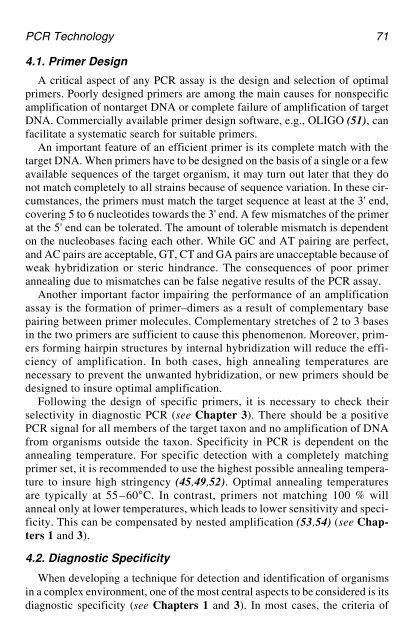PCR Detection of Microbial Pathogens PCR Detection of Microbial ...
PCR Detection of Microbial Pathogens PCR Detection of Microbial ...
PCR Detection of Microbial Pathogens PCR Detection of Microbial ...
You also want an ePaper? Increase the reach of your titles
YUMPU automatically turns print PDFs into web optimized ePapers that Google loves.
<strong>PCR</strong> Technology 71<br />
4.1. Primer Design<br />
A critical aspect <strong>of</strong> any <strong>PCR</strong> assay is the design and selection <strong>of</strong> optimal<br />
primers. Poorly designed primers are among the main causes for nonspecific<br />
amplification <strong>of</strong> nontarget DNA or complete failure <strong>of</strong> amplification <strong>of</strong> target<br />
DNA. Commercially available primer design s<strong>of</strong>tware, e.g., OLIGO (51), can<br />
facilitate a systematic search for suitable primers.<br />
An important feature <strong>of</strong> an efficient primer is its complete match with the<br />
target DNA. When primers have to be designed on the basis <strong>of</strong> a single or a few<br />
available sequences <strong>of</strong> the target organism, it may turn out later that they do<br />
not match completely to all strains because <strong>of</strong> sequence variation. In these circumstances,<br />
the primers must match the target sequence at least at the 3' end,<br />
covering 5 to 6 nucleotides towards the 3' end. A few mismatches <strong>of</strong> the primer<br />
at the 5' end can be tolerated. The amount <strong>of</strong> tolerable mismatch is dependent<br />
on the nucleobases facing each other. While GC and AT pairing are perfect,<br />
and AC pairs are acceptable, GT, CT and GA pairs are unacceptable because <strong>of</strong><br />
weak hybridization or steric hindrance. The consequences <strong>of</strong> poor primer<br />
annealing due to mismatches can be false negative results <strong>of</strong> the <strong>PCR</strong> assay.<br />
Another important factor impairing the performance <strong>of</strong> an amplification<br />
assay is the formation <strong>of</strong> primer–dimers as a result <strong>of</strong> complementary base<br />
pairing between primer molecules. Complementary stretches <strong>of</strong> 2 to 3 bases<br />
in the two primers are sufficient to cause this phenomenon. Moreover, primers<br />
forming hairpin structures by internal hybridization will reduce the efficiency<br />
<strong>of</strong> amplification. In both cases, high annealing temperatures are<br />
necessary to prevent the unwanted hybridization, or new primers should be<br />
designed to insure optimal amplification.<br />
Following the design <strong>of</strong> specific primers, it is necessary to check their<br />
selectivity in diagnostic <strong>PCR</strong> (see Chapter 3). There should be a positive<br />
<strong>PCR</strong> signal for all members <strong>of</strong> the target taxon and no amplification <strong>of</strong> DNA<br />
from organisms outside the taxon. Specificity in <strong>PCR</strong> is dependent on the<br />
annealing temperature. For specific detection with a completely matching<br />
primer set, it is recommended to use the highest possible annealing temperature<br />
to insure high stringency (45,49,52). Optimal annealing temperatures<br />
are typically at 55–60°C. In contrast, primers not matching 100 % will<br />
anneal only at lower temperatures, which leads to lower sensitivity and specificity.<br />
This can be compensated by nested amplification (53,54) (see Chapters<br />
1 and 3).<br />
4.2. Diagnostic Specificity<br />
When developing a technique for detection and identification <strong>of</strong> organisms<br />
in a complex environment, one <strong>of</strong> the most central aspects to be considered is its<br />
diagnostic specificity (see Chapters 1 and 3). In most cases, the criteria <strong>of</strong>






